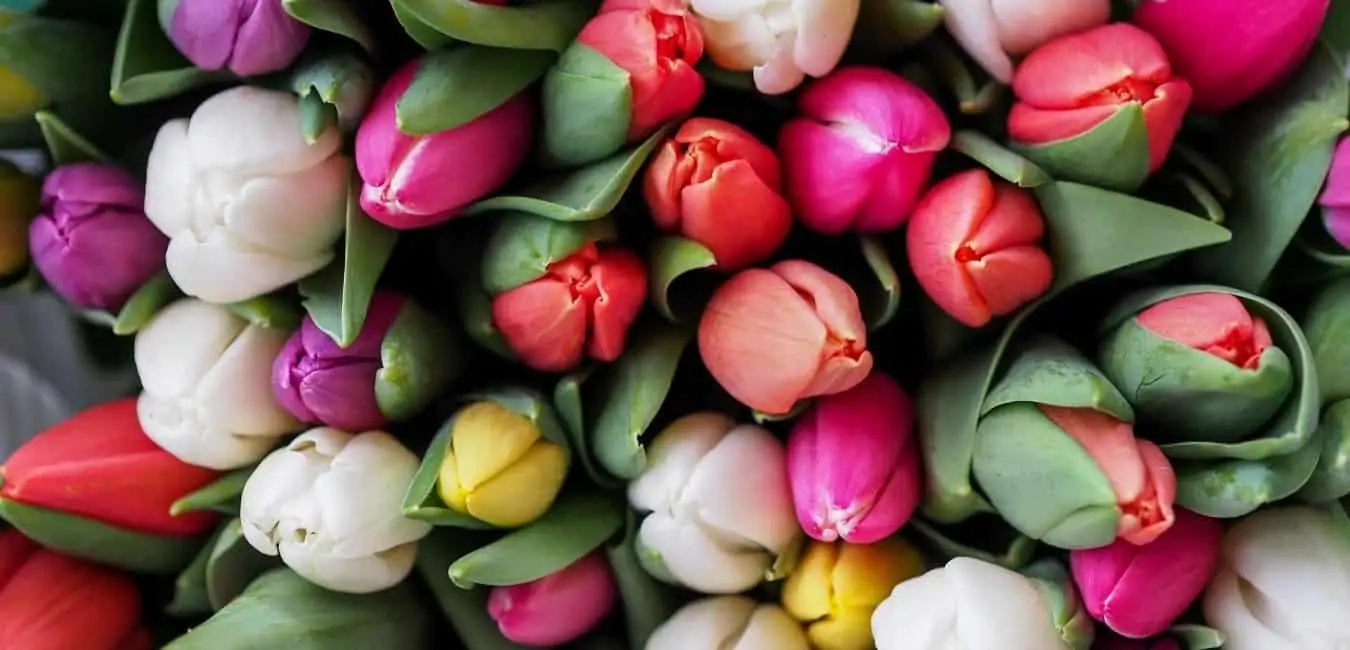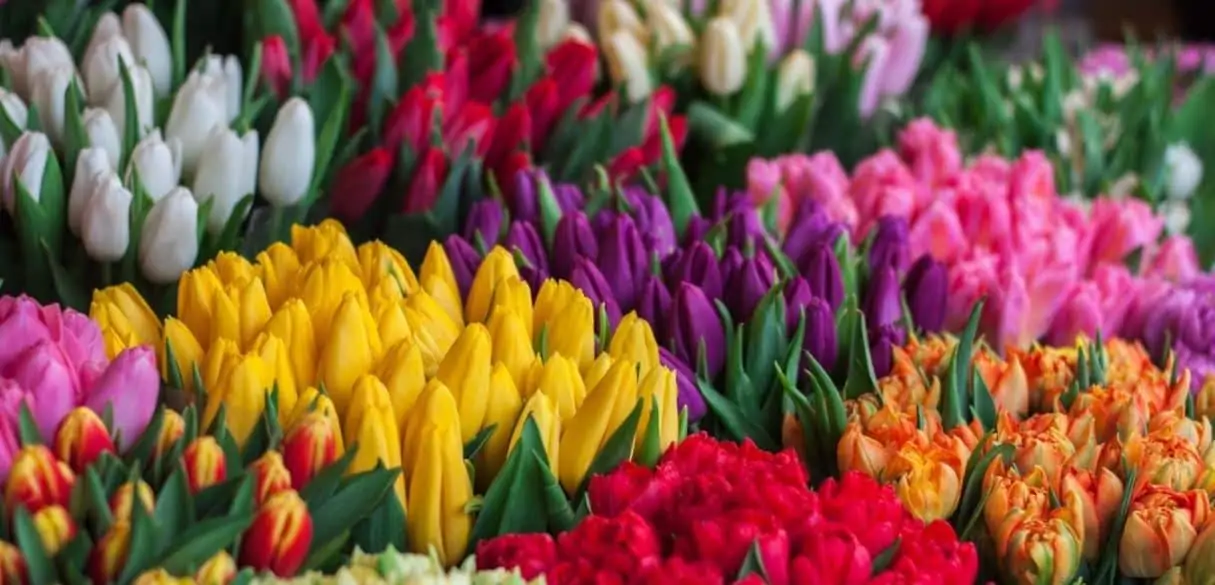Do you own a Tulip Garden? If not then this is the time to plan for next season. We have already present articles on growing and caring for Tulips. Today we will discuss the Tulip Temperature Requirements. It is an essential topic to understand. Both Temperature and water have a direct impact on the bloom time and quality of Tulips. So if you know the basics then you can amend the resources to get the best bloom this year.
Tulips to Tulipa spp. is a beautiful Winter perennial flower. It is grown from bulbs. Bulbs are the fleshy leaf portion of the basal section of the plant. It connects the leaves with the root system. Tulip bulbs can stay alive in the soil in a dormant state for more than a year. hot dry Summer season is the dormant or inactive time for Tulips. The Tulip plant loses all its leaves during summer. Only the bulbs remain alive waiting for cool winter. The fall wakes up these bulbs from dormancy and winter encourages new growth. Tulips require more water in spring than summer due to their active growth period. Tulips are hardy in USDA hardiness zones 3 to 9. You can grow tulips in USDA zone 10 or 11 with proper heat protection. Keep reading for more interesting details about Tulips.
Tulip Temperature Requirements: 45 to 60 degrees Fahrenheit.

Check out my previous post: Why is My Tulips Turning Yellow? 12 Reasons to Know
Temperature Requirement to grow Tulips
Every Gardener must know the answer- How much temperature is required to grow Tulips? Tulips are winter-favorable plants. It stays dormant throughout the summer. So the temperature requirement is precise to grow Tulips.
Most Tulips varieties bloom best in the temperature ranges of 55 to 65 degrees Fahrenheit. A temperature lower than 30 degrees or higher than 73 degrees Fahrenheit is not good for Tulips. Although Tulips can sustain a temperature above 70 degrees the bloom will deteriorate.
The native climate allows Tulips to cool down slowly for 6 to 12 weeks in the winter. The temperature also drops day by day in the winter season, not at once. It starts falling from the 50s to 40-degree Fahrenheit in 6 to 8 weeks. The lowest temperature hit is probably 25 or 30 only for a couple of days. Then again the soil temperature starts rising towards 50 to 55 degrees. This rise will again take 4 to 6 weeks.
The Tulip bulbs have successfully sprouted by this time. These plants will bloom in another 4 or 5 weeks at a constant temperature around 60 degrees Fahrenheit. Tulip blooms indicate the end of the last frost in the locality.
Check out my Favorite Garden Products on Amazon
Vernalization or Wintering Tulips at Low Temperature
Tulip bulbs remain dormant throughout summer. It wakes up with the fall in temperature. In this way, you can get only 1 bloom in the spring season. It is a natural process and not a big problem for most of us- the Home gardeners. But the problem occurs if you don’t get enough cold in winter or if you want Tulips to bloom in summer or fall. In these situations, the normal growth pattern of the Tulip plant is not feasible.
That’s why most commercial flower cultivators use a technique called Vernalization. Vernalization is a Technique to cool down bulbs to mimic winter conditions. We can fool the Tulip bulbs to wake up early from dormancy and grow whenever we want the bloom.
Stored Tulips bulbs are placed into coolers for 4 to 6 weeks to drop down their temperature to optimum 40 degrees. This temperature drop is not done at once, instead every week the temperature is lowered to 2 to 3 degrees until it reaches 38 to 40 degrees.
Usually, the Tulip bulbs are stored at 60 to 70 degrees Fahrenheit in cool, dark, dry, and well-ventilated storage areas.
This gradual temperature drop will create an artificial winter condition for the Tulip bulbs. Vernalization will help the bulbs to come out of dormancy whenever we need to grow tulips.

Also read: How to Remove Wilted Tulip after Blooming?
Significance of Cooling Tulip Bulbs at low Temperature
Artificial cooling of Tulips bulbs can help you to get the blooms whenever you want. Mimicking winter-like conditions by cooling the bulbs will wake them up from summer dormancy. The Tulip bulbs will start developing new roots at this low temperature. A strong root system will help the plant to grow stronger and develop bigger healthier blooms.
Commercially vernalization is a very profitable technique. As you can get Tulip lowers throughout the year without worrying about the spring timing.
It is a commercial technique this doesn’t mean that we as home gardeners can’t use it. If you have a cooler or refrigerator then you can place the Tulip bulbs with cocopeat or peat moss in the vegetable section. DOn’t freeze the bulbs or they may die. You can’t drop the temperature day by day at your home refrigerator still the usual temperature is sufficient to grow and vernalize Tulip bulbs. So don’t worry give it a try and share your experience with us.
Forcing or Thawing Tulips bulbs for faster Blooming
Once your Tulip bulbs are properly vernalized. It is the time to mimic the early spring condition. Usually, this is the time when the soil starts thawing or warming day by day. So we have to replicate the same.
If you experience short winter then you can directly put the vernalized tulip bulbs in the raised garden beds. They will grow fine within the next 4 to 6 weeks. Else in a cold unfavorable condition, Place the bulbs in healthy soil mix in a container inside a greenhouse. Let the container be placed in a corner where it can receive direct sunlight.
The Tulip will grow and develop new leaves and more foliage. It will start developing flower spikes or stocks after 6 weeks at 55 to 60 degrees Fahrenheit. Try not to warm the temperature above 65 degrees to maintain good flower quality.
The Vernalized Tulip bulbs will take 4 to 5 weeks to bloom at 65 degrees and 8 weeks at 50 degrees Fahrenheit. Therefore control the temperature according to your needs. Tulips will bloom faster at higher temperatures but the bloom size may reduce due to immature blooming.
Check out: How to Grow Tulips in a Greenhouse?
Importance of Forcing for Tulips
Forcing a Tulip bulb can help you to get the bloom in time. It is commercially helpful especially to obtain Tulip blooms when the demand is high. You can earn more by selling Tulips during the festival or wedding season Instead of the spring season.
You can get the blooms faster by forcing as compared to the natural blooming of tulips. It can take anywhere from 10 to 15 weeks for the Tulip bulbs to bloom without vernalization and force. Whereas you can achieve all of these within 10 weeks at any time of the year.
Impact of sudden temperature change on Tulips
Tulips are hardy in USDA zone 3 to 9. In these locations, most Tulips can thrive from late winter to early summer. The bloom will end in the summer and the plant will fall asleep to dormancy through the summer. The bulb will remain alive in the soil and wakes up again in the fall. This is the usual growth pattern of most tulips in their hardiness zones.
If the temperature suddenly changes during dormancy then it can wake up prematurely at low temperature. Else the bulb may dry out due to overheating. Both of these situations are very rare and you can hardly notice any change either in the bulb or upcoming growth.
But if the temperature changes suddenly during the growth period especially before blooming. Then the plant can show certain signs of damage. If the temperature rises quickly above 60 degrees the Tulip plant can blot and form premature blooms. Else the foliage can turn yellow and plants can die. If the temperature change is done with control then you can get the best bloom in your tulips. else the chance of losing your plants at least for this season is pretty high.
Also read: When to Plant Bulbs in Greenhouse?
Can we grow Tulips in warm and Hot areas?
Yes, we can grow Tulips in hot and Warm geo locations even if it lies above USDA zone 9. The best option is always to select a heat and drought-resistant variety of Tulip to grow in a warm location.
You should prepare a partial shade to grow tulips in warm or hot areas. Choose the season carefully as winter is the ideal time to grow tulips. Start Your tulips in the fall or Autumn and let them settle throughout the winter.
It is possible that you will get early bloom in winter due to temperature changes. Though These blooms will not be of optimum size and quality. Still, you can expect to get some more in late winter and early spring with proper care.
In hot areas where temperature can exceed 90 degrees Fahrenheit, you should grow Tulips in the proper shade. Overhead sunlight is harmful in these situations. Only allow early morning and late evening sunlight to reach the Tulip plants. Regulate the watering to avoid dehydration of the Tulips.
The proper measure should be taken to keep the surrounding temperature low enough to encourage quality bloom in tulips. You can use a temperature control greenhouse set up in these areas to grow Tulips and Other cool-weather flower plants.
Final Words
If you really want to grow tulips in your garden Then follow Tulip Temperature Requirements with care. A tulip plant needs 45 to 60 degrees Fahrenheit to grow and bloom. It is a cool winter flower. So try to create a winter-like situation if you want to grow throughout the year. If you are new to Tulips or flower gardening then Stay tuned for more details.
Ask your question, share your experience. Keep reading and Keep Gardening!

